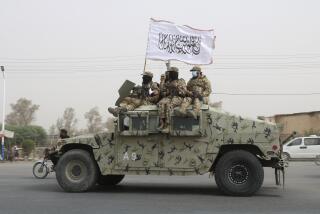3-Day Riot by Taliban Prisoners Quashed
- Share via
MAZAR-I-SHARIF, Afghanistan — Tossing grenades into a prison basement in a grisly rout of the last few holdouts, the Northern Alliance on Wednesday quelled a three-day rebellion by Taliban prisoners near this northern Afghan city.
Corpses of fighters and horses littered the prison yard at Qala-i-Jangy, where about 500 Taliban fighters had been held in a 19th century fortress that also served as military headquarters for the top Northern Alliance general in northern Afghanistan, Abdul Rashid Dostum. All of the prisoners are believed to have died in the uprising.
Dostum said the Taliban prisoners, who surrendered during the fall of the northern city of Kunduz, had been disarmed but not painstakingly searched. He described the siege by the prisoners as a kind of double-cross.
“We could have tied their hands and legs, but I trusted their goodwill,” Dostum said. “I’m very upset that I lost about 40 of my best soldiers and about 200 were injured.”
Appearing to belie Dostum’s assertions, an Associated Press photographer said that he had seen some corpses with their arms tied with cloth. There was no indication whether they had died in U.S. airstrikes called in to end the uprising, in the fighting itself, or whether they were executed.
In London on Tuesday, Amnesty International called for an inquiry into the “proportionality of the response” to the uprising by alliance fighters and U.S. and British military personnel.
A Pentagon official, when asked Wednesday to provide details of the uprising, said that many questions remain unanswered.
“At some point in this detainee status, [the Taliban prisoners] then came to some sort of a decision to . . . take some action and had the ability to be able to do that,” said Rear Adm. John D. Stufflebeem, deputy director of the Joint Chiefs of Staff. “There’s a lot of questions that obviously need to be asked or answers that need to be obtained as to how that came about or how that can be prevented in the future. My sense is that the opposition groups learned quite a bit from this experience, as well as what we have observed.”
Covert CIA officer Johnny “Mike” Spann was killed in the uprising, becoming the United States’ first combat death in Afghanistan. Five American soldiers were wounded when a U.S. bomb landed off target.
Spann’s body was recovered Wednesday and was en route to the United States. Also Wednesday, the Red Cross began collecting the bodies of the Taliban prisoners.
The incident at the prison west of Mazar-i-Sharif recalled a similar siege two weeks ago in which perhaps more than 1,000 Taliban soldiers made a last stand inside a former girls school in the city. Nearly all the Taliban fighters were killed in the battle.
The prison uprising began Sunday, when a Taliban prisoner detonated a hidden grenade. In the ensuing confusion, some prisoners managed to seize weapons from their captors and fought their way to the fortress’ ammunition depot.
For the next three days, the prisoners used the stored ammunition to fight off Dostum’s forces. A U.S. military advisor called in airstrikes on the besieged section of the fortress, and more than 30 strikes were counted Monday and Tuesday.
“This is a military fortress, a stronghold. It is resistant to rocket attacks,” Dostum said. “That’s why they managed to hold us off for so long.”
Dostum’s forces also transported thousands of other Taliban prisoners across northern Afghanistan on Wednesday, in preparation for what the general said would be talks with the United Nations over their fate.
Brightly painted open-bed trucks crammed with surrendered Taliban trundled along the road to Mazar-i-Sharif in a convoy Wednesday, guarded by pickups full of heavily armed Northern Alliance fighters.
The prisoners were sullen, with road dust plastering their faces and grime darkening their turbans. The guards refused to allow them to talk to reporters.
“I don’t know what is going to happen to them,” said commander Osman Khan, who was supervising the convoy as it moved into Mazar-i-Sharif. “Gen. Dostum is going to talk to the United Nations about them.”
The fate of the defeated Taliban fighters has complicated the Northern Alliance’s recapture of the country.
About 6,000 Taliban soldiers have surrendered to Dostum in recent days, many of them Arabs, Pakistanis or other non-Afghans. Some are believed linked to the Al Qaeda terrorist network run by exiled Saudi millionaire Osama bin Laden.
Dostum is believed to have offered the surrendered fighters safe passage to the southern Taliban enclave of Kandahar; U.S. officials have said they would not approve of any outcome in which the Taliban fighters escaped custody or death.
Most of the Taliban prisoners surrendered to Dostum after Kunduz fell to the Northern Alliance on Monday.
*
Times special correspondent Mukhabat Primkulova in Mazar-i-Sharif and staff writer John Hendren in Washington contributed to this report.
More to Read
Sign up for Essential California
The most important California stories and recommendations in your inbox every morning.
You may occasionally receive promotional content from the Los Angeles Times.













